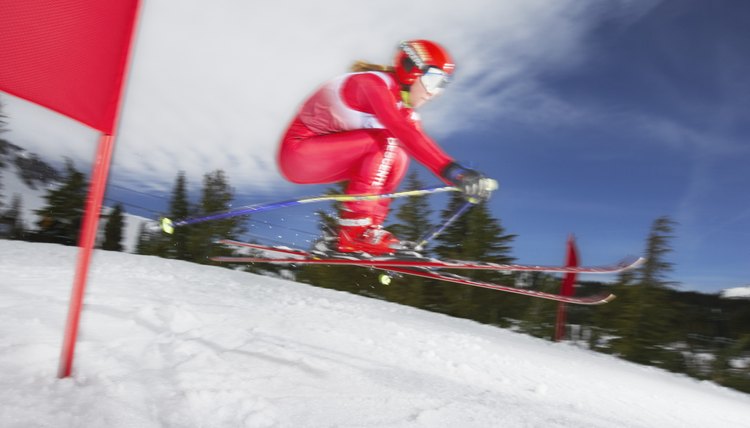Blisters on the Legs From Skiing

New physical activities often come with new sources of discomfort until your body adjusts to unfamiliar stress and demands. Sports and exercises that require prolonged mobility, including skiing, often cause blisters on the feet and legs when these body parts are exposed to unaccustomed and ongoing friction and pressure. After skiing for awhile, you may develop protective calluses in the same areas where you first had blisters. Blisters and injury can be minimized or prevented by wearing the correct clothing and gear.
Cause
Continuous friction and pressure against your skin are the root causes of blisters, including those on your legs from skiing. While snow pants or other garments may put pressure or friction on your legs, the most likely culprit is your ski boots. If your ski boots are too tight, blisters form from continuous pressure on your legs; if they're too loose, they can rub up and down on your legs as you ski. If your legs get sweaty underneath the bundle of clothing you wear while skiing, this facilitates blister formation. The top layer of skin separates from the layer underneath and a fluid that acts as a cushion seeps in between.
Treatment
Blisters on your legs after skiing don't require any treatment; they go away on their own in a few days. However, if your blisters cause pain or discomfort, you do have the option of popping them. If you're on a ski trip, this may be necessary to prevent the blisters from interfering with your enjoyment of the vacation. Wash your hands and legs with warm water and soap, then sterilize a needle, the blisters and the surrounding patches of skin with rubbing alcohol. Stick the needle just through the top layer of separated skin, at the very edge of each blister. Allow the fluid to fully drain, and wipe it away. Apply a topical antibiotic and cover the wound with a bandage. Avoid putting pressure or friction on the affected areas until they heal.
Prevention
Appropriate, properly fitting ski boots and ski clothing, including socks, are essential to prevent blisters on your legs during your skiing excursions. There are different types of boots for different types of skiing and terrain. Buy your ski equipment from a knowledgeable vendor who can advise you on the type of boots you need. Make sure the ski boots fit snugly, but not tightly. Acrylic socks minimize friction, notes an article in "The Physician and Sportsmedicine." Douse your feet and legs with baby powder before suiting up to keep them free of sweat. If you know of areas on your legs that are prone to blisters, put a bandage or second-skin type protective product over the spots.
Warnings
Don't drain blood blisters, cautions the Sports Injury Clinic. These occur when a blood vessel is damaged from friction or pressure that causes a blister and blood seeps into the area between the layers of skin. Blood blisters present greater risk of infection than other blisters. Infection is the primary concern with all blisters, particularly after you pop them. Use a topical antibiotic and change the bandages over your leg blisters twice a day and whenever they get wet or dirty. Leave the top layer of skin on the blisters for extra protection. If you experience increased redness, pain, inflammation, oozing or other possible signs of infection, see a doctor right away.
References
- The Physician and Sportsmedicine: Athletic Skin Injuries
- SportsInjuryClinic.net: Blisters
- KidsHealth: Blisters, Calluses and Corns
- Shashikumar B, Reddy RR, Harish M. Oral hemorrhagic blister: an enigma. Indian J Dermatol. 2013;58(5):407. doi:10.4103/0019-5154.117337
- Worthing RM, Percy RL, Joslin JD. Prevention of Friction Blisters in Outdoor Pursuits: A Systematic Review. Wilderness Environ Med. 2017;28(2):139-149. doi:10.1016/j.wem.2017.03.007
- Harvard Health Publishing, Harvard Medical School. Frostbite 404 404.
- Institute For Preventive Foot Health. Causes of Blisters.
- PathologyOutlines.com. Skin - nontumor, Blistering disorders, Blood blister.
- U.S. National Library of Medicine, Medline Plus. Blisters.
Writer Bio
Eric Mohrman has been a freelance writer since 2007, focusing on travel, food and lifestyle stories. His creative writing is also widely published. He lives in Orlando, Florida.
